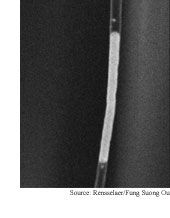|
NEWS
|
Particles gang up on tumors
A type of nanoparticle made of peptides homes
in on cancer tumors and recruits other nanoparticles to
gather there, mimicking the way platelets accumulate at
wounds. This self-amplifying accumulation could be used
to concentrate contrast agents and anti-cancer drugs to
improve imaging and treatment of cancer tumors. (Biomimetic
Amplification of Nanoparticle Homing to Tumors, Proceedings
of the National Academy of Sciences, January 16, 2007)
Cell takes in more sun
An early prototype shows that intermediate-band
solar cells should be able to double the 25 to 30 percent
efficiency of today's best commercial solar cells. The
prototype is made of nanoscale bits of semiconductor material
and achieved a power conversion efficiency of 45 percent.
(Intermediate-Band
Solar Cells Employing Quantum Dots Embedded in an Energy
Fence Barrier, Nano Letters, January 10, 2007)
Nanotubes sport nanowire ends
 Growing carbon nanotubes fused end-to-end with
metal nanowires opens a route to making nanoscale interconnections
between nanotube circuits. The work could help make nanoelectronics
more practical, which could lead to future generations
of low-power, high-speed computer chips. (Multisegmented
One-dimensional Hybrid Structures of Carbon Nanotubes
and Metal Nanowires, Applied Physics Letters,
December 11, 2006)
Growing carbon nanotubes fused end-to-end with
metal nanowires opens a route to making nanoscale interconnections
between nanotube circuits. The work could help make nanoelectronics
more practical, which could lead to future generations
of low-power, high-speed computer chips. (Multisegmented
One-dimensional Hybrid Structures of Carbon Nanotubes
and Metal Nanowires, Applied Physics Letters,
December 11, 2006)
Nano spot welding
A copper-filled carbon nanotube attached to an
electron microscope makes a handy spot welder for joining
nanotubes and other nanoscale objects. The device is the
nanoscale equivalent of the robotic welders used to assemble
automobiles. (Nanorobotic
Spot Welding: Controlled Metal Deposition with Attogram
Precision from Copper-Filled Carbon Nanotubes, Nano
Letters, January 10, 2007)
Nanotubes ID DNA electronically
A method of measuring electronic interactions
between DNA and carbon nanotubes could lead to ways of
electronically identifying DNA sequences. Electronic DNA
identification has the potential to be much faster than
today's chemical methods. (DNA
Nucleoside Interaction and Identification with Carbon
Nanotubes, Nano Letters, January 10, 2007)
DNA does multi-sensing
Two-dimensional arrays of DNA nanotiles can identify
multiple types of nucleic acids, proteins and other biological
molecules in a single sample. The arrays could be used
for rapid medical diagnostics and drug discovery. (Self-Assembled
Combinatorial Encoding Nanoarrays for Multiplexed Biosensing,
Nano Letters, published online January 18, 2007) |
FEATURES
|
View
from the High Ground: ICL's John Pendry
Physics as machine tool, negative refractive
index, metamaterials, shattered wine glasses, higher capacity
DVDs, scientific backwaters, risk perception and practice,
practice, practice.
|
How
It Works: Quantum computing: qubits
Photons, electrons and atoms, oh my! These particles are
the raw materials for qubits, the basic building blocks
of quantum computers. |
|
 |
News RSS feed 
Blog RSS feed 
Bookshelf RSS feed

New: TRN's
Internet Services
TRN's Jobs Center
|
| |
|
| |
|
| |
"Physics
is to the rest of science what machine tools are
to engineering. A corollary is that science places
power in our hands which can be used for good or
ill. Technology has been abused in this way throughout
the ages from gunpowder to atomic bombs."
- John Pendry, Imperial College London |
|
| |
|
| |
Thanks
to Kevin from
GoldBamboo.com
for technical support |
|

